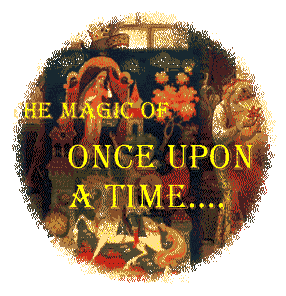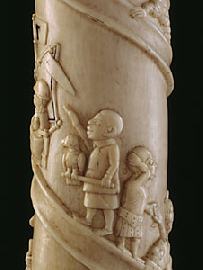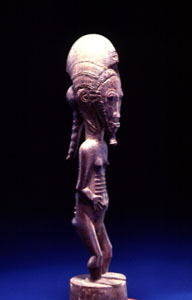|

Narrative Logo - Click for Main Menu
Lecture
VIII. The Socio-Economic Interpretation of Folktales
Modern
Collections and their Implications 1& 2
preview (optional)

Caption: Ivory carving of African Characters
From Mything Links
An Annotated & Illustrated Collection of
Worldwide Links
to Mythologies, Fairy Tales,
Sacred Arts & Traditions
Kathleen Jenks, Ph.D.
"Man with a Bird on a Perch"
The bird may be a gray parrot, associated with magic and sacred divination
Detail of a Carved Ivory Tusk, "Spiral of History"
Congo: Loango Coast, mid to late 1800's // National Museum of African Art at the Smithsonian Institute, Washington
(Permission Pending)

Caption: Mayan God-face
In the last twenty years, the real "folk" among us
have nearly disappeared. Traditional folklore scholars have tried to go to the
source for their tale research - isolated hamlets where people have little contact with the
outside world, exotic countries where ancient stories are still told in ritual social
gatherings and privately, at bedtime. But these pockets are harder and harder to
find. Since oral tales are always changing as long as they remain in the
spoken culture (and not written down), the purity of material collected today is
questioned by the traditionalists. For example, one might wonder what happens to the
telling of an ancient tale by a person who has visited McDonald's!
McDonald's goes on conquering the world with 25.000
restaurants in
115 countries and with 40 millions meals per day. Every five hours it
opens a new restaurant. In Europe the only country that
resisted the great golden "m" invasion is Albany. France,
though always so chauvinist and self-sufficient in the culinary field, is
not an exception: 630 McDonald's on the French soil, for a total
turnover of 7 billions francs. In
the Czech Republic, McDonald's uses for its campaign the image of a
nail, and as slogan a sell off of an old nursery rime ("little nail, little
nail, show your little horn…"). Conscious irony or fate irony?
Similarly, traditionalists would object that a tale related by someone carrying a
cell phone, watching television every night, and rocking to music in the automobile has
been hopelessly contaminated - and might not be a reliable source of story-telling
authenticity.
There are two ways around this problem. The first is to
acknowledge it, and to call whatever one finds "contemporary folklore." In
this category we would put the genre of Urban Legends, jokes, office and e-mail gags, etc.
The second way around the problem is to conduct the scholarship
in such a way as to eliminate as much intrusive material as possible. This always
involves a value judgment - and it is instructive to look at how those judgments
are made
because, in a sense, everything we know about historical folklore is filtered in this way.

African Mask
African Art,
This week, we will start with the second method and look at some
modern collections of ethnic tales. Then we will move on to contemporary folk finds.
Here are some good books that are available at
Amazon.com and might represent folklore you would like to know more about:
Ella E. Clark, Indian Legends of the
Pacific Northwest. University of California Press.
Vance Randolph, Pissing in the Snow
and Other Ozark Folktales. University of Illinois Press.
James Riordan, Russian Gypsy Tales.
Interlink Books, New York.
Bruce Chatwin, The Songlines.
Penguin Books.
Martha Beckwith, Hawaiian Mythology.
University of Hawaii Press.
Roberta H. Markman and Peter T. Markman,
The Flayed God: the Mythology of Mesoamerica. Harper San Francisco.
you will notice that many of these are
published by University presses. These presses are a good place to start if you are
looking for something specific. The WWW and Amazon.com also have many resources for
print books.

Caption: Male
Statuette of a Wilderness Spirit
Baule group, Senufo peoples, Ivory Coast
Wood with unknown sacrificial material
height 15-1/2"
The Baule, who are associated with the Akan peoples, are located on the Ivory Coast of
Africa.
Within the African art world, the Baule are especially known for their figure carvings.
Unlike many
African groups which reserve the right of carving to certain individuals, all members of
the Baule group
are permitted to create figure carvings. These figures serve one of two spiritual
meanings. The first is
that of a spirit spouse, who is the wife or husband that each individual is believed to
possess in the
other world.
Just to look more closely at one culture whose folklore has been
collected and expanded in this century, let us visit Hawaii.
One fascinating book on Hawaiian legends is Hawaiian
Mythology by Martha Beckwith. Beckwith started recording Hawaiian stories in
1914 (Beckwith was in her mid-thirties). In 1940, at age seventy, she published the
original version of this ms. She was still revising when she died, in 1955, at age
84. The current version was published in 1970, paperback in 1976.
so, a long and arduous labor of love. And, as you would
expect, an incredible in-depth look at the Hawaiian tales and chants and their
relationship to the folkstock of the Pacific Islands.
Beckworth writes: "Hawaiians
use the term kaao for a
fictional story or one in which fancy plays an important part, that of moolelo for a
historical figure, one which is supposed to follow historical events. Stories of
gods are moolelo. They are distinguished from secular stories not by name but by the manner of telling. Sacred
stories are told only by day, and the listener must not move in front of the
speaker...."
so don't move!
Polynesians and
Pacific Islanders have a rich and entrancing tradition that is embodied
largely in song. Song, like
poetry, is a mnemonic device for the preservation of oral tradition. Hawaiian
chants
did survive from centuries ago, and they tell of many tales that link the shared culture
heroes of the Pacific Islands. All the way from the Maori to Honolulu, the god,
Maui, was known in some form.
a couple of Maui stories from the Maui Myths page:
BIRTH OF IAO NEEDLE
Once in Old Hawaii, in the days when anything was possible, Maui, the most
powerful God, had a beautiful daughter. Maui loved her very much and as he
watched her grow up, he vowed that only the most worthy King in all the
islands would marry her.
But without her father knowing, the beautiful maiden fell in love with
Puuokamoa, a Merman God. She knew that her father wouldn't approve, so
they kept their romance secret. Every day the beautiful maiden sneaked off to
meet her love and every night she returned home, radiant. One day, a
townsperson saw the two of them together and ran back and told Maui of his
daughter's secret lover.
Maui was furious. He flew into a rage and his screams of anger were heard
by Madame Pele, the volcano Goddess. She flew in her supernatural way to
where Maui was and suddenly appeared in front of him.
"What is so horribly wrong to put you in such an uproar?" Madame Pele
asked.
"My beautiful daughter has fallen in love with a God and I disapprove. When
I see him, I am going to have him condemned to a fiery death", Maui said.
"Who is this God?", Pele asked.
"His name is Puuokamoa".
Madame Pele frowned at the mention of his name. "Oh no, Puuokamoa is my
friend. Spare him, Maui. I beg you. Do not have him killed".
But Maui would not listen. Madame Pele was still pleading with him when his
beautiful daughter returned. She heard her father's death sentence on her
lover and burst into tears.
"Oh Father", she sobbed, "I cannot live without the sight of
Puuokamoa".
The Father's heart softened at the sight of his daughter and thinking that she
would be unhappy for the rest of her life if she could not see the man she
loved. Finally, after much thought, Maui put his arms around his daughter
and lifted up her beautiful face. Tears soaked her unhappy eyes.
"Daughter dear, I cannot bear to see you unhappy", Maui said tenderly. "But
I cannot allow this romance to continue. You cannot marry this Merman
God".
His daughter waited to hear what her powerful father had decided. Madame
Pele stood quietly, waiting to hear the fate of her friend.
"I will not reduce him to ashes", Maui said.
"Oh, father dear", the daughter cried out, hugging him.
"I will turn him into stone. Then you may gaze upon him, but your romance
will be pau (over)".
And that is how the mountain, known as the Needle, at Iao Valley came to be.
It is the Merman God turned to stone for all to gaze upon.
STORY OF MAUI
Eons ago, there was born the Demigod Maui. His father was the holder of the
heavens and his mother was the guardian of the path to the Netherworld.
Maui was the only one of the children who possessed the powers of magic and
miracles.
Maui was the smallest of the family. He had the quickest of mind and had an
extremely rascally nature about him. Maui would take any advantage of both
his friends and the gods in his quest to fulfill his schemes.
It is said that Maui was not a good fisherman. His brothers were much more
skilled. They would often laugh at him for his poor success. In revenge, Maui
used his cunning to fill his boat with catch at his brothers expense. Maui
would position his boat so that when one of his brothers began to pull in a
fish, he would distract them so that he could pull his line across theirs stealing
their fish.
Maui's brothers could only marvel at their younger brother. However they
soon caught on and refused to take him fishing with them. Maui's fortune
turned against him. His mother then sent him to his father to obtain a magic
hook.
"Go to your father. There you will receive the hook called Manaiakalani, the
hook fastened to the heavens. When the hook catches land, it will raise the
old seas together."
Maui returned with his hook. He joined his brothers in another fishing
expedition. They jeered him and threw him out of the boat. When they
returned, they were empty handed. Maui berated them. He stated that if they
had allowed him to join them, they would have had better success. The
brothers decided to allow him to join them in their canoe for another chance.
They paddled far into the deep ocean and threw their lines overboard. To
their dismay, they only caught sharks. The brothers ridiculed Maui asking
"Where are the fish you promised?"
Maui then rose and threw his magical hook into the ocean. Chanting a spell of
power, he commanded the hook to catch the Great Fish.
At once the sea began to move. Great waves rose around the canoe. Maui
commanded his brothers to paddle with all their might and to not look back.
For two days, Maui held taut the magic line and hook while his brothers kept
paddling furiously. Suddenly from below the depths arose the tops of great
mountains in a series of peaks that broke the surface of the ocean. Maui
reminded his brothers to keep paddling mightily. Maui pulled mightily against
the line and forced the peaks even farther out of the water.
One of his brothers then broke the command and gazed back in awe at the
sight of the rising land. He stopped paddling and quickly the magic line began
to slacken in Maui's hands. Before he could call out to his brothers, the line
snapped and the magic hook was lost forever beneath the sea.
Maui chastised his brothers for their failure to paddle as he had commanded.
"I had endeavored to raise a great continent but because of your weakness I
have only these islands to show for all my efforts."
And this is how the Islands of Hawai'i came to be...
a story of Maui and the STARS:
Title: Maui's Hook
Tribe: Polynesian
Region: South Pacific
Object: Scorpius
Maui was a powerful god but a poor fisherman. He snagged his hook (Scorpio) and line on
the
bottom of the sea and thought he had hooked a big fish. He pulled hard and pulled up the
Hawaiian Islands.
An Hawaiian Chant
Mâpu ka hanu ô ka laua'e
Mâpu noe ka poli ô ka wai aloha
Aloha i ke kapa 'ehu kai,
Huki palai, huki, lohe, noi kahua.
Noe mai la ka lehua makanoe.
Noe ka lehua makanoe,
Noe wiwo'ole i ke anu,
Anu i ke ala kîpapa ola e,
Ala e kuhikuhi lima kanaka 'o Mauna Hina ê.
E hina nô paha 'o wau wale nô.
E hina nô paha e kâua, e ka `aha nui ê.
Alia lae!He anu, he anu wale nô |
Wafted is the breath of the laua'e fern.
The essence of the beloved waters alights like mist.
Beloved is the covering of the sea spray,
Drawing concealment listening, inquiring intently.
The lehua of the misty face brings mist.
The lehua of the misty face brings mist.
The mist unafraid of the cold,
The cold of the pathway of life.
Mauna Hina is a pathway directing mankind.
Perhaps it is just I who will succumb.
Perhaps you and I, or the large assembly, will succumb.
Wait!
Cold, just cold! |
Early Hawaiians recorded their literature in memory, not
writing. They composed and maintained an extensive oral tradition, a
body of literature covering every facet of Hawaiian life. Chants, called mele, recorded
thousands of years of ancient Polynesian
and Hawaiian history.
Chants also recorded the daily life of the Hawaiian people, their love of the land, humor
or tragedy, and the heroic character of
their leaders. A mele chant is a poetic form of song that tells a story.
They can be
classified into two general categories, mele oli
and mele hula.
Mele oli
Unaccompanied chant, usually performed by one person at ritual occasions such as a birth,
a death, or the
departure of a ranking chief. Mele oli also recounts historical events and tells stories
and legends
Mele hula
Accompanied by dance movements alone, or by dance movements with musical instruments such
as the drum, pahu, and gourd rattle, 'uli'uli
Audio: A mele oli entitled "Mapu Ka Hanu O Ka Laua'e (Wafted is the breath of the
Laua'e Fern)," performed by Pualani
Kanaka'ole Kanahele.
and to conclude with this section, one to
think about, from the Native American Star Lore page:
Title: Moon rapes the Sun
Tribe: Inuit
Region: Northern Canada
Object: Sun, Moon
A brother and sister went to a dance house one night. A windstorm blew out the seal-oil
lamps and during the darkness a man grabbed the sister and raped her. He finished before
the lights could be restored and she didn't know who he was. The next time they went to
the dance house the sister first smeared her hands with soot. Again the lamps blew out and
the man raped her but this time she smeared the soot on his back. When the lights returned
she discovered that the attacker was her brother. She was enraged. "Such things are
not done!" she screamed. She took a knife and cut off her breasts and threw them at
him saying "Here you are, you enjoy them so much!" She grabbed a torch and ran
out. The brother grabbed a torch and followed her but he tripped and fell in the snow. His
torch was put out but the embers still glowed. Just then the wind swept them into the sky
where she became the Sun and he became the Moon. She continues to stay away from him as
best she can. If his torch had not fallen in the snow the Moon would now be as bright as
the Sun.
Continue
with Lecture VIII.
|




